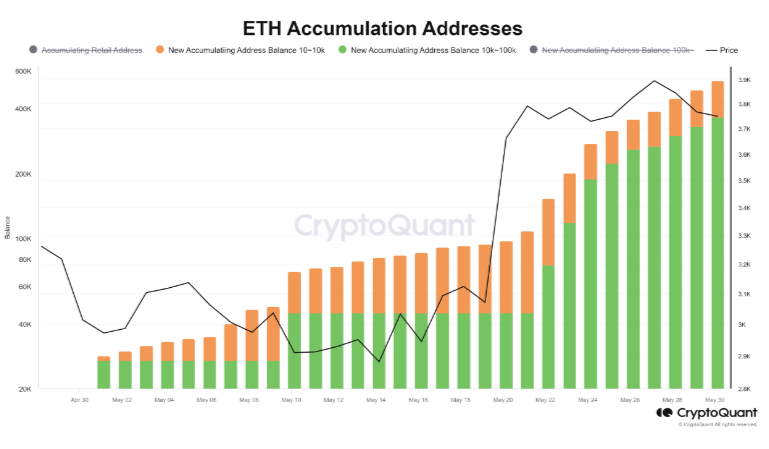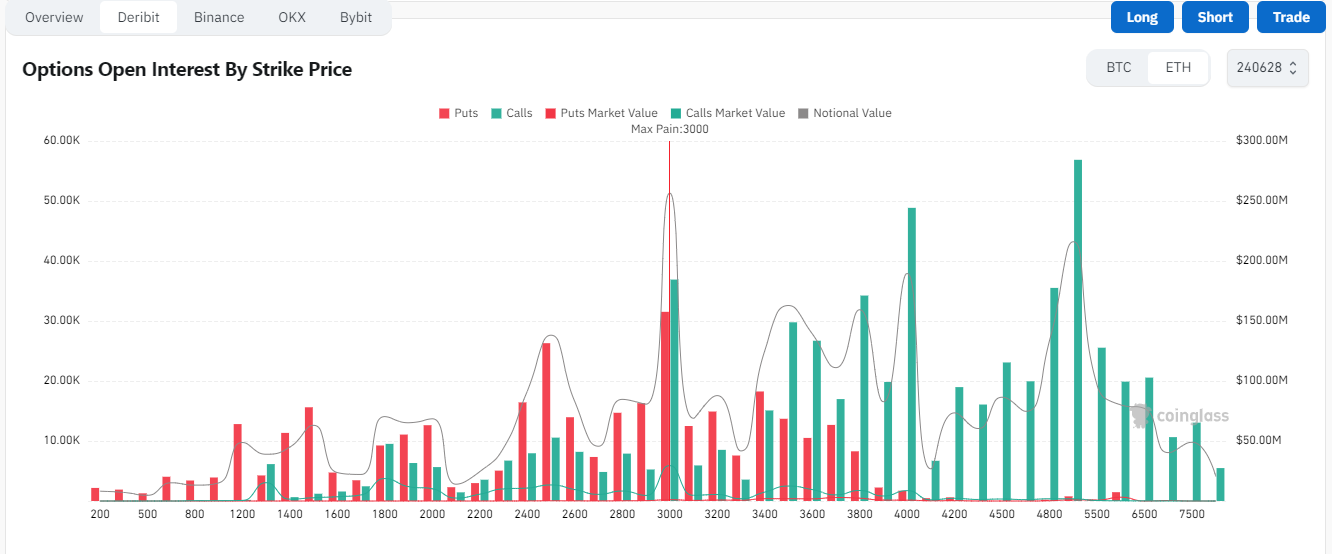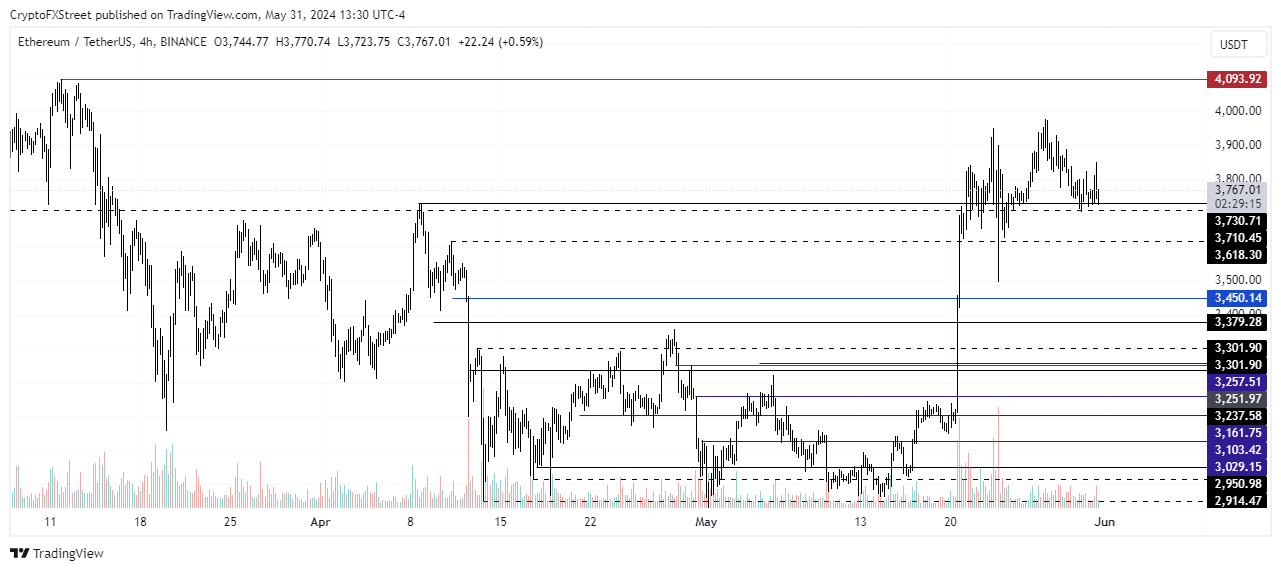- Six issuers submitted updated S-1 filings with key changes to the SEC.
- Ethereum accumulating addresses have increased steadily since the beginning of May.
- Ethereum derivatives data indicates traders are highly bullish.
Ethereum (ETH) maintained a stable price on Friday following on-chain and derivatives data pointing to increased bullishness among investors. Meanwhile, six issuers submitted their updated S-1 ETH ETF registration statements with the Securities & Exchange Commission (SEC), revealing key changes in their structure.
Daily digest market movers: Increased accumulating addresses, Grayscale filings, JP Morgan predictions
Ethereum is at the center of key discussions in the crypto market as spot ETH ETFs continues to spark debate. Here are the latest stories surrounding the top altcoin:
On Friday, six issuers, including Fidelity, Van Eck, Franklin Templeton, Invesco Galaxy, Bitwise, and 21 Shares, submitted their updated spot ETH ETF S-1 registration statements with the SEC. This completes the total number of submissions from the eight issuers whose 19b-4s were approved on May 23. BlackRock and Grayscale submitted their amended S-1s earlier in the week.
Franklin’s updated statement notably included a 0.19% fee, suggesting a potential fee war among issuers.
“For context, most ether spot ETFs in other countries or in other vehicles are >1%. The US ETF market is just special in its hard core ness but that’s why vast majority of new inv cash flowing here,” said Bloomberg analyst Eric Balchunas. Nate Geraci, President of ETF Store, drew attention to Grayscale speculating whether its Ethereum Mini Trust fees will be priced the same as its high Bitcoin ETF fees.
Read more: Ethereum price lags, investors potentially reallocating capital after BlackRock’s updated S-1 filing
Also, 21Shares’ updated S-1 revealed that Ark is no longer in its name, meaning it will launch the spot ETH ETF alone.
“As for Ethereum, Ark believes in its transformative potential and the long term value of the Ethereum blockchain but, at this time, Ark will not be moving forward with an Ethereum ETF,” wrote Ark Invest.
Amid the S-1 filings, Tuttle Capital and Rex Shares filed for two 2x Ethereum ETFs even though spot ETH ETFs are yet to go live.
2x Ethereum ETFs filed even before the 19b-4 ink has dried on the regular ones
T-Rex 2X Inverse Ether Daily Target ETF | $LETH
T-Rex 2X Long Ether Daily Target ETF | $NETHBoth 1.25% fees
Effective date: Aug 14, 2024Will be based on daily performance of yet-to-be launched… pic.twitter.com/FYb5vDDkYf
— ETF Hearsay by Henry Jim (@ETFhearsay) May 31, 2024
In the past few days, several crypto community members and key players have said that spot ETH ETF approval was political and indicated Democrats are becoming more pro-crypto. However, President Joe Biden’s recent veto of SEC’s SAB121 rule on Friday sent shock waves across the crypto market, suggesting spot ETH ETF approval may be due to other reasons.
“Highly supports my theory that spot eth ETF approval *wasn’t* driven by politics. SEC didn’t want to get sued (& lose) again. Case for approval was pretty straightforward IMO,” said Nate Geraci.
Bloomberg analyst Eric Balchunas, who earlier suggested that spot ETH ETF approval was political, responded to Geraci’s post, stating he was surprised by the move.
“I’m shocked by this tbh.. altho my theory still has mounds of circumstantial evidence But this def helps your case a bit,” replied Balchunas. However, he still maintains that the ETH ETF approval was political.
Two weeks ago, everyone thought spot eth ETFs would be denied…
Now, we have approved 19b-4s & amended S-1s in from eight issuers.
You love to see it.
— Nate Geraci (@NateGeraci) May 31, 2024
Meanwhile, according to data from CryptoQuant, the number of new addresses accumulating ETH has grown steadily in May despite prices remaining relatively stable. Notably, new accumulating addresses with a balance of 10,000 to 100,000 ETH skyrocketed and have been growing steadily following rumors and the eventual approval of spot ETH ETF 19b-4 filings.
ETH Accumulation addresses
ETH technical analysis: Ethereum derivatives data indicates bullishness
Ethereum is trading around $3,740 on Friday, maintaining its horizontal movement.
ETH liquidations data also reveals the neutrality among bulls and bears, with $16.66 million of liquidated long positions and $12.12 million of shorts.
However, while prices lag, derivatives data from Deribit shows that Ethereum options’ open interest is largely made up of calls at a strike price of $5,000, indicating bullish sentiment among traders. Data from Coinglass also confirms this as it shows Deribit’s put/call ratio (PCR) for options expiring in June at 0.36.
The put/call ratio measures the volume of puts vs calls. If the ratio is below one, it indicates a skew toward bulls and vice versa if it is above 1.
ETH Options Open Interest By Strike Price
ETH will likely see a major breakout when the SEC gives more clarity on spot ETH ETF S-1 registration statements, according to QCP Capital analysts.
Read more: Top 3 Price Prediction Bitcoin, Ethereum, Ripple: Facing correction after ETFs led rally
Hence, ETH may tackle the $4,093 resistance. If successful, it may go on to set a new all-time high above $4,878.
ETH/USDT 4-hour chart
Ethereum FAQs
Ethereum is a decentralized open-source blockchain with smart contracts functionality. Serving as the basal network for the Ether (ETH) cryptocurrency, it is the second largest crypto and largest altcoin by market capitalization. The Ethereum network is tailored for scalability, programmability, security, and decentralization, attributes that make it popular among developers.
Ethereum uses decentralized blockchain technology, where developers can build and deploy applications that are independent of the central authority. To make this easier, the network has a programming language in place, which helps users create self-executing smart contracts. A smart contract is basically a code that can be verified and allows inter-user transactions.
Staking is a process where investors grow their portfolios by locking their assets for a specified duration instead of selling them. It is used by most blockchains, especially the ones that employ Proof-of-Stake (PoS) mechanism, with users earning rewards as an incentive for committing their tokens. For most long-term cryptocurrency holders, staking is a strategy to make passive income from your assets, putting them to work in exchange for reward generation.
Ethereum transitioned from a Proof-of-Work (PoW) to a Proof-of-Stake (PoS) mechanism in an event christened “The Merge.” The transformation came as the network wanted to achieve more security, cut down on energy consumption by 99.95%, and execute new scaling solutions with a possible threshold of 100,000 transactions per second. With PoS, there are less entry barriers for miners considering the reduced energy demands.
Source

